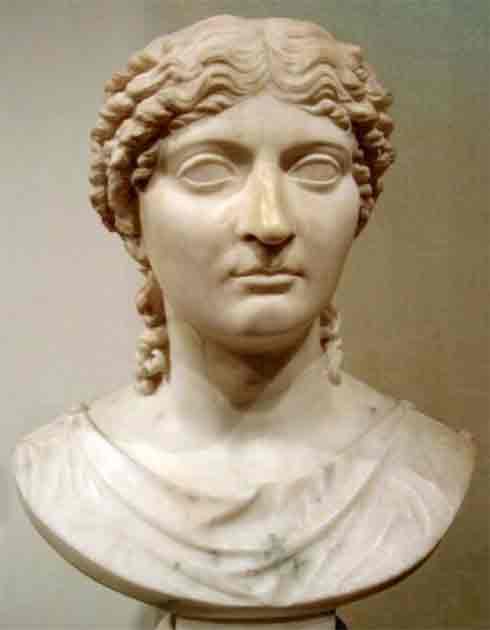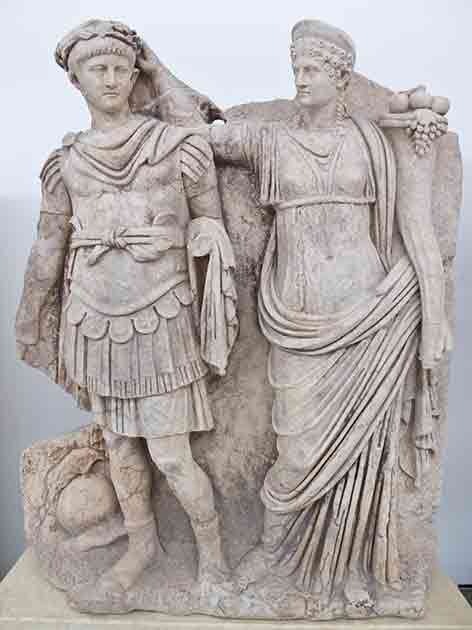The first few Roman Emperors included some pretty bad guys. The jury is out on Caligula, who may have been more sinned against than sinning (although he was still very much a despot) but there is no doubt on Nero.
Nero was such a hated figure that some believe he was immortalized in the Bible with the famously evil number “666” being a cryptic reference to his name. Decadence and over-extravagance, incest, the murder of members of his family, and the destruction of much of old Rome while he watched: all of these can be laid at his door.
But behind Nero was a cabal of like-minded evil. Perhaps the nastiest figure that lurked in the shadows behind the throne was Locusta of Gaul, a figure steeped in infamy.
Renowned for her mastery of poisons, she emerged as a deadly instrument in the hands of Emperor Nero, shaping the course of history with each lethal brew. Behind closed doors, her clandestine deeds whispered of treachery and intrigue, as she wielded her toxic arts to eliminate rivals and threats alike.
And yet, we know so little of the truth. Who was Nero’s legendary poisoner, Locusta of Gaul? Serial killer, opportunist, or victim?
The Imprisoned Poisoner
Despite her relative fame, there’s a lot we don’t know about Locusta of Gaul, including how she first came to Rome. Some historians believe that she was taken to Rome as a slave. Since Julius Caesar’s
victorious campaign over Gaul in the 50s BC, Rome had taken as many as one million slaves from the region and it makes sense Locusta may have been one of them.

Most of what is known about Locusta comes from the Roman historians Tacitus, Suetonius, and Cassius Dio, men who never met her and may have embellished the truth to make it more interesting. We first know of her in 54 AD, when Locusta was already in jail for being a poisoner.
It would seem that she had started out on her own, a serial killer in ancient Rome who had been caught and imprisoned. It was this reputation which led Agrippina the Younger, wife of the notorious Emperor Claudius, to seek her out.
Agrippina had married Claudius in 49 AD but soon began having second thoughts. According to Tacitus, she turned to Locusta for “some rare compound which might derange his mind and delay death”: in other words, a poison that was hard to detect. She settled on Locusta because the prisoner was, “a person skilled in such matters […] who had lately been condemned for poisoning” and presumably had nothing to lose.
Supposedly, Locusta advised Agrippina to use Atropa Belladonna. The plant had been a go-to for poisoners since early antiquity and atropa-derived poisons were often used in Roman murders. In fact, some believe that Empress Livia, wife of Augustus, had taken out many rivals with the plant.
Locusta told the emperor’s wife to sprinkle the poison on a mushroom. This mushroom was then served to Claudius by his food taster, and Agrippina’s accomplice, Halotus.
This attempt was botched, however, and failed to kill Claudius. Instead, his doctor, Gaius Stertinius Xenophon, was forced to finish Claudius off by apparently pushing a poisoned feather down his throat. The doctor claimed this was to induce vomiting.
Poisoner to Nero’s Court
Not long after Claudius’s death Agrippina’s son, Nero, claimed the throne with his mother as his advisor. Nero had taken the throne by bypassing Claudius’s son from his third marriage, Britannicus. Technically, this stepbrother had a stronger claim to the throne than Nero, something the young, newly crowned emperor couldn’t abide.
Around a year into his reign, Nero decided he needed to discretely do away with Britannicus. Lucky for him, his mother knew just the person to help him do it.
Locusta was still imprisoned and in 55AD Nero came to her cell demanding a poison that would kill Britannicus instantly. In exchange, she would receive a full pardon. With no other choice, she agreed.
Locusta cooked up a brew of belladonna, arsenic, hellebore, and mandrake and supplied it to Nero. Unfortunately for her, Britannicus must have had a stronger constitution than most because the poison failed to kill him quickly.
An enraged Nero (pretty much his default state) returned to Locusta’s cell and flogged her as punishment. He told her if her next poison didn’t finish the job, he would have the poisoner executed. She obliged.
At an imperial dinner, Nero’s servants brought the unlucky stepbrother a hot drink. Britannicus was rightly cautious and had his taster test it. It was deemed safe but too hot, so Britannicus called for water to cool it down.

That water contained Locusta’s new poison. This time it did the job. Britannicus began convulsing and fell to the ground, Nero ordered no one to touch him, claiming it was an epileptic fit.
Locusta’s Fate
Nero was over the moon. He didn’t just pardon Locusta, he gifted her a large country estate with servants ordered to serve her every whim. He then frequently sent her students whom she taught how to create the ancient world’s most deadly toxins.
For a long time, things looked up for Locusta. She lived a life of relative luxury under Nero’s protection until 68 AD, the year everything came falling down.
Over the years Nero had become increasingly unpopular and in 68 AD the Senate announced Nero had gone from being a nuisance to a public enemy. His time had run out.
With few allies left Nero decided to commit suicide. At some point before his death, he had asked Locusta for a poison he could use on himself in case of emergencies, which he kept in a little golden box. In the end, he chose another method.
After Nero’s death Rome’s new emperor, Galba, began rounding up Nero’s closest associates. Alongside Nero’s other favorites, people described as “the scum that had come to the surface in Nero’s day,” Locusta was dragged through the city in chains and publicly executed.
In the years following her death, Roman historians vilified Locusta, but not everyone is convinced she was as bad as they claimed. In the 1st century AD, it became a trend for Roman historians to rip apart emperors like Nero and Caligula who represented the antithesis of traditional Roman values.
Claiming Nero used a woman to poison his enemies made him look like a weakling and a coward. Poison was seen as a woman’s weapon: emperors should fight bravely and confront their rivals face to face.

As such the tale of Locusta was a way for Nero’s enemies to criticize him. Could it be that historians embellished the truth to make Nero look bad, sullying Locusta’s name in the process?
We’ll never know for sure. It seems likely that Locusta was a well-known poisoner but that much of her history was exaggerated for political purposes.
Some see her as one of history’s first serial killers, others as an unwitting pawn in Rome’s game of thrones. It’s entirely possible she was everything they said she was, but we can never know for sure.
Top Image: Locusta of Gaul was already in prison for poisoning when the Roman Imperial family sought her out. Source: Simeon Solomon / Public Domain.